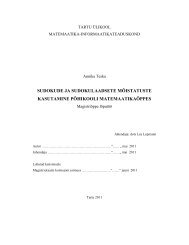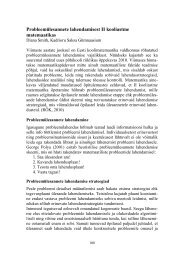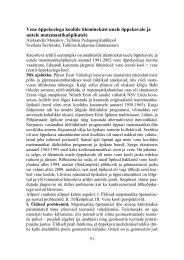Artikli fail
Artikli fail
Artikli fail
You also want an ePaper? Increase the reach of your titles
YUMPU automatically turns print PDFs into web optimized ePapers that Google loves.
of Mathematics Education (3). Norwich, UK: University of East Anglia,<br />
385–401.<br />
11. Noelting, G. (1980). The development of proportional reasoning and<br />
the ratio concept. Part 1 – Differentiation of stages. Educational Studies<br />
in Mathematics (11), 217–253.<br />
12. Norton, S. J. (2005). The construction of proportional reasoning. Proceedings<br />
of the 29 th Annual Conference International Group for the<br />
Psychology of Mathematics Education (4). Melbourne, Australia: University<br />
of Melbourne, 17–24.<br />
13. Nurk, E., Telgmaa, A., Undusk, A. (2000). Matemaatika VII klassile.<br />
Tallinn: Koolibri.<br />
14. Proportional Reasoning: A Research Based Unit of Study for Middle<br />
School Teachers (2007). Rhode Island: Department of Education Office<br />
of Instruction.<br />
15. Steinthorsdottir, O. B., Sriraman, B. (2009). Icelandic 5th-grade girls’<br />
developmental trajectories in proportional reasoning. Mathematics Education<br />
Research Journal (21), 6–30.<br />
16. Tourniaire, F., Pulos, S. (1985). Proportional reasoning: A review of<br />
the literature. Educational Studies in Mathematics (16), 181–204.<br />
17. Van de Walle, J. A. (2007). Elementary and middle school mathematics:<br />
Teaching Developmentally. Boston, MA: Pearson Education.<br />
Students’ reasoning strategies in proportional reasoning<br />
problems<br />
Kait Kleemann, Oru School<br />
Jüri Kurvits, Tallinn University, University of Helsinki<br />
Summary<br />
Proportional reasoning has been described as a watershed concept, a cornerstone<br />
of higher mathematics. Proportionality is a fundamental concept<br />
in middle grades mathematics and plays a critical role in students’ mathematical<br />
development. It has important implications for higher-level mathematics<br />
and can be seen as a link between elementary school arithmetic and<br />
the more abstract high school mathematics. Furthermore, it is not only important<br />
in mathematics but also in our everyday life as many situations revolve<br />
around the idea of ratio and proportion.<br />
In this paper we focus on the reasoning strategies that middle grades students<br />
use when solving proportional word problems. In addition, we discuss<br />
the concept of proportional reasoning and briefly describe the developmental<br />
trajectory of proportional reasoning.<br />
36
















